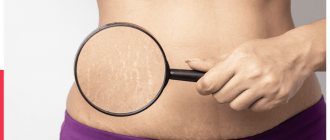Causes of weight gain during pregnancy
There are cases when young mothers do not gain a single extra kg during pregnancy. This is usually due to genetics and body type. However, most women still face the problem of excess weight after childbirth. “Pregnancy leaves its natural imprint on a woman’s body: often during pregnancy we move less, eat more, and taste preferences can change significantly,” says the rehabilitation specialist at the sports medicine clinic. “The body does what nature intended to carry the baby as safely and comfortably as possible and prepare for its birth. Therefore, weight gain during pregnancy is an absolutely normal situation.”
First of all, there is no need to panic and you should be patient. “During pregnancy, body weight increases, and this is normal - on average, a woman can gain 9-14 kg. Firstly, the fetus itself, amniotic fluid and the enlarged uterus,” explains an expert in the group programs of the largest fitness club in Russia. - Secondly, adipose tissue, which accumulates mainly in the abdomen and thighs to protect the fetus and, in addition, serves as an additional reserve of energy to ensure the survival of the mother and unborn child in case of unforeseen circumstances. This mechanism is physiologically inherent in a woman’s body, and fighting it is pointless and unsafe. In addition, an increase in the mammary glands and the volume of circulating blood also adds weight.
Pregnancy lasts 9 months, and it’s stupid to expect that the form will be restored in a month or two - at least the same amount of time should pass.”
Therefore, experts recommend not to panic because of the “gain”, not to go on strict diets, but to focus, first of all, on motherhood and improving your own well-being.
When can you start losing weight after giving birth?
There is no clear answer to this question. “Regarding the weight loss process, there is no reason to wait for any specific period, but only if your diet is balanced. In reality, most women are ready for this after only a couple of months or six months, says Evgenia Mayevskaya, Ph.D., gastroenterologist and nutritionist at GMS Clinic.
After giving birth, many women strive to begin to return their body to its “pre-pregnancy” appearance as soon as possible. “But there is no need to rush this process. If there are no contraindications, the mother feels comfortable and sleeps enough, then the process of gradual, competent weight loss can begin after lactation has completely improved. But this is an ideal situation; in reality, young mothers don’t get enough sleep, the baby cries or is capricious, and there are just more household chores,” explains the rehabilitation specialist at the sports medicine clinic. — The result is a tired body and an exhausted nervous system. It’s pointless to start losing weight in this state: even if you push yourself into strict limits and lose a few kilograms, they will return as soon as the resource of moral and volitional efforts runs out.”
Balance your diet during and immediately after feeding
You should not undereat while feeding. This way you can deprive your baby of essential vitamins and even cause toxins to appear in the milk. Daily breastfeeding will require a lot of energy - approximately 500 kcal per day. “It is worth remembering that breast milk is obtained from the mother’s lymph and blood, so all preservatives, dyes and stabilizers can enter breast milk, causing negative reactions (including skin reactions) in the child,” says Evgenia Mayevskaya. — Therefore, you need to build your diet with a minimum of such products, or better yet, exclude them. For smooth weight loss, you need to reduce your caloric intake by about 300-350 kcal from the original, taking into account that a woman secretes up to 40 g of fat per day through breast milk, and then the process of weight loss will not take long.”
Here are some general nutritional recommendations from Evgenia Mayevskaya:
- It is necessary to include proteins, fats and carbohydrates in the diet, as well as fiber in the form of non-starchy vegetables (about 400 g);
- No need to starve;
- It is important to drink enough liquid (approximately 1.8-2.0 liters including water and other drinks);
- Limit the amount of simple carbohydrates through sweets and baked goods (contain a lot of fat and sugar);
- Leave natural sugars in the form of fruit (about 250-300 g);
- Additionally, take preventive doses of vitamin D;
- It is acceptable to take iodine, iron, calcium and multivitamins, but only after consulting a doctor.
Also remember that a nursing mother’s meals should be fractional – 4-5 times a day. You need to eat right! The diet should include complete proteins (lean meat, fish), foods rich in calcium (for example, low-fat cheese 10–17%), fruits and vegetables. Avoid rich meat broths, fish soup and borscht: they contain a lot of extractive substances that are slowly digested and thereby complicate the body’s recovery.
Eat small portions every two to three hours - this will make it easier for you not to overeat.
Consult with doctors
Be sure to see your doctor for one year after giving birth. 6 months after the baby is born, have a complete blood count and hormone tests done. It is necessary to make sure that the hormonal levels have stabilized.
If you cannot lose weight for a long time, go for a consultation with an endocrinologist and nutritionist. Perhaps after childbirth the functioning of the endocrine system or metabolism was disrupted. In addition, you should definitely go to the doctor if, within 2-3 months after giving birth, your ovarian function is not restored and menstruation does not begin.
What does this mean for a newborn?
When the birth process is difficult, this, of course, affects not only the mother’s body, but also the child’s. For serious complications, modern obstetricians and gynecologists use the term “disappointing fetal status,” recommended by the American College of Obstetricians and Gynecologists (ACOG). It includes symptoms such as irregular heartbeat, poor motor activity and muscle tone, and low amniotic fluid. The most common causes of “disappointing fetal status” are:
- hypoxia – low oxygen levels;
- maternal anemia;
- arterial hypertension in the mother;
- intrauterine growth retardation;
- meconium (primary stool) in the amniotic fluid (the risk of this complication is highest when the expectant mother carries the baby for more than 42 weeks).
Another serious complication is perinatal asphyxia, a condition in which a newborn's blood has low levels of oxygen and high levels of carbon dioxide. Because of this, acidosis occurs - “blood acidification”, the functioning of the cardiovascular system and internal organs is disrupted. The baby receives a low Apgar score, and it persists for more than 5 minutes, he has a pale, bluish skin color, a rare pulse, decreased muscle tone, and weakened breathing.
Severe complications can arise from malpresentation, when the fetus, due to its not entirely physiological position in the uterus, is much more difficult to come out. Normally, the buttocks should be adjacent to the exit from the uterus, but in some cases it may be the legs, face, forehead, crown. Sometimes the child is in a transverse position in the uterus, and in this case it is completely impossible to be born naturally. Depending on the type of presentation, this problem is solved differently. In some cases, it is possible to correct the presentation by using the correct position of the mother’s body and “pushing” the fetus with her hands through the abdominal wall. Sometimes you have to resort to obstetric forceps or perform an episiotomy - cutting through the vaginal wall and perineum. In some cases, a caesarean section is indicated.
In one out of 200 pregnancies, placenta previa is detected - when the “baby place” is partially or completely adjacent to the exit from the uterus. This condition threatens severe bleeding and is an indication for cesarean section. The risks are increased with a large number of previous pregnancies, especially if they were also accompanied by placenta previa, twins and triplets, uterine fibroids, a woman’s age over 35 years, and smoking.
In some cases, problems with the umbilical cord are the source of fetal complications. It can wrap around the baby’s neck and press his body parts tightly against the wall of the pelvis. Because of this, blood flow is disrupted, hypoxia and asphyxia occur. If a woman's pelvis is too narrow and the fetal head is too large, it cannot pass through the birth canal. A caesarean section is required. Another problem that may be associated with a narrow maternal pelvis is fetal shoulder dystocia. The bottom line is that after the birth of the head, the shoulders get stuck. There are special techniques with which obstetricians and gynecologists can help such babies be born. However, this threatens the newborn with some complications:
- injury to the brachial plexus and disruption of the innervation of the arm and hand;
- fracture of the humerus or collarbone - in newborns they heal very quickly;
- brain damage due to insufficient oxygen supply is the most severe complication.
Normally, the labor process lasts from 6 to 18 hours. But sometimes it happens too quickly - in 3-5 hours. This threatens the child with injuries, aspiration (entry into the respiratory tract) of amniotic fluid, and the risk of infection if the mother is in unsterile conditions, for example, giving birth at home or in an ambulance.
Forget about Hollywood stars
“Envy Heidi Klum, a mother of four children, who still manages to look perfect? In vain! - says the modeling agency nutritionist. “Sharp weight loss after the birth of a child (within 2-3 months) can negatively affect metabolism, lead to loss of milk and subsequently affect your health and the health of the baby.”
Remember: a whole army of nannies and nutritionists helps the stars. Monitoring the condition of your body is part of the profession of Hollywood divas. Unless you're a fashion model, TV presenter or singer, you don't have to get back into shape in record time. And if you’re a fashion model, you don’t have to either: health comes first!
How does this affect the duration of maternity leave?
If everything went well and there were no complications, the mother receives a leave of 140 days: 70 in the prenatal period and the same amount after the birth of the baby. In case of complications or multiple pregnancies, the period increases.
If there are complications, the maternity leave is increased by 16 days: 70 in the prenatal period and 86 after, a total of 156. When twins or triplets are born, the maternity leave is increased by 54 days: 84 in the prenatal period and 110 after, a total of 194.
These deadlines are set by the antenatal clinic doctor and made a note on the exchange card. Then the woman receives a certificate of incapacity for work and must present it to the accounting department at her place of work. Following this, leave is granted and benefits are calculated. It is important to understand: the terms of maternity leave associated with complications and the birth of twins or triplets do not add up. Therefore, if the mother of twins has already gone on maternity leave for 194 days, she will not be given more, even if there were complications. It is also impossible to get two maternity leave in the postpartum period.
Don't eat depression
The main enemy of weight loss after pregnancy is postpartum depression. Most often, it is what contributes to nervous breakdowns and overeating.
Symptoms of postpartum depression: unreasonable tears, irritability, headaches, fatigue, sleep disorders. “During pregnancy, the level of hormones (estrogen and progesterone) in a woman’s body increases,” says an endocrinologist. — These hormones are responsible for the preservation and proper course of pregnancy. Immediately after childbirth, their levels drop sharply, and a new hormone, prolactin, begins to be produced. The body is being rebuilt rapidly – hence the mood swings.” You need to fight them not with food, but with the help, for example, of playing sports. The support of loved ones is very important. If depression is severe, it is better to consult a specialist.
Don't rush to the gym - take a walk in the fresh air
You shouldn’t immediately try to do everything that you could do before in a fitness club. At first, just walk longer with your baby in the fresh air. Start with 20 minutes a day, then increase your walking time and walking pace. Twenty minutes of brisk walking with a stroller burns about 150 kcal. “Walking is mandatory for both the baby and the mother - walking, being the most natural and safest type of cardio exercise, will help improve lymph flow and blood circulation, help saturate tissues with oxygen, and gradually tone muscles,” adds the expert in group programs .
Get into training mode correctly
During pregnancy, the body undergoes quite dramatic changes. “A growing belly and a shifting center of gravity can lead to an increase in lumbar lordosis and, accordingly, discomfort in this area; the lower ribs diverge, changing the shape of the chest; the diaphragm, supported from below, rises and “freezes” during the exhalation phase, which affects breathing. Therefore, at first, classes should be aimed at improving mobility of the lower back and chest and breathing, says an expert in group programs. — No sudden or intense movements, everything is as smooth and calm as possible. In the first 10-14 days after birth, when the volume of the uterus decreases, you should give preference to exercises while lying down. This can be gentle rocking and circular movements of the pelvis, aimed at improving mobility of the lower back, breathing with an emphasis on the movement of the ribs and diaphragm. Gradually, you can move on to sitting exercises (a fitball is perfect) - similar pelvic rotations, chest movements, breathing.”
After 1-2 months, you can move on to more active activities. Before this, you should check for the presence of diastasis. “Diastasis is a stretching of the linea alba, causing the rectus abdominis muscles to literally move apart, causing them to not work properly. If this problem is not addressed, then dysfunction of the abdominal muscles over time can lead to lower back pain, protrusions and hernias, and prolapse of organs. In addition, visually the stomach will remain protruding or hanging, even despite training and weight loss,” says the fitness trainer.
How to check if you have diastasis? Lie on the floor with your knees bent and your feet flat on the floor. Place one hand under your head and get ready to palpate your stomach with the other. “Raise your shoulders and shoulder blades and feel the linea alba of your abdomen (from the xiphoid process of the sternum to the navel and a little lower), paying attention to the distance between the abdominal muscles (you can clearly feel the edges of the muscles and the soft tissue between them, where your fingers literally fall through, if not - great, you don’t have diastasis). Then relax and lower yourself to the floor. Pre-activate your internal muscles—tighten your pelvic floor and transverse abdominis muscles, pulling your stomach in slightly, and then lift your shoulders and shoulder blades back up. Palpate the abdomen again and compare the sensations - if the abdomen has become hard and the fingers do not fall through, then the diastasis can be removed by working on the internal muscles, but if nothing has changed and the width of the diastasis is more than 4 cm, surgery may be required,” she adds.
“If a mother is diagnosed with diastasis or there is a suspicion of diastasis, the usual, well-known types of abdominal exercises are categorically not recommended: folding, leg lifting and body lifting, twisting, corner, etc. They can lead to a worsening of the situation with diastasis. But there is a way out of this situation - a set of exercises for a gentle postpartum recovery. They consistently strengthen the abdominal muscles and eliminate all symptoms of diastasis. After some time, the young mother will be able to do her favorite exercises,” she adds.
Weak pelvic floor muscles can also be a limitation to exercise. “These small muscles, like the abdominal muscles, are located in the perineum and are an integral part of the “internal cylinder”. Their weakness can be expressed in organ prolapse, symptoms of urine leakage when coughing and sneezing, when jumping, and in discomfort during sexual intercourse. If a young mother decides to exercise, she needs to make sure that there is no prolapse of organs or weakness of the pelvic floor muscles,” says a rehabilitation specialist at a sports medicine clinic.
4-6 weeks after vaginal birth, you can begin gentle training. If you gave birth by caesarean section, you will have to wait longer - 6-8 weeks: the stitches on the abdomen must heal completely. “To continue recovery after childbirth, Pilates, yoga, swimming and water aerobics are great during this period. During lactation, you should reduce the load on the chest muscles, and also avoid jumping to avoid injury to the mammary glands. Of course, you should avoid any intense training that causes an increase in adrenaline levels, as this will negatively affect the quality and quantity of milk. Any intense workout is stressful, and under stress, the body switches to energy saving and survival mode,” adds the fitness trainer.
You can start training fully 4-5 months after giving birth - yoga, Pilates, and light running are suitable. After finishing feeding, more intense exercises are possible - dancing, water aerobics. Many fitness clubs have special programs for mothers and babies.
You can also train at home while your child is sleeping. Do simple exercises for all muscle groups (here and here) and pay attention to stretching. And when the child wakes up, try to involve him in the activities.
Beautiful breasts after childbirth
During breastfeeding, the breasts become heavier, the load on the ligaments and skin increases. Will she change her shape after giving birth? Everything is individual here. This depends on the condition of the skin and muscles before childbirth, as well as the size of the breasts.
Did you know that after childbirth, not only the breast itself temporarily increases due to the influx of milk, but often the chest as well? In the later months of pregnancy, some of the internal organs rise higher than usual. 2 months after birth, the chest will return to normal volume.
Doctors recommend that mothers wear special underwear during pregnancy and after it. Some may not need it at all - depending on their own preferences, as well as the condition and size of their breasts, many women can opt for thick T-shirts or T-shirts, sports bras or regular bras with wide straps and comfortable cups. It is important that the selected underwear is made from natural fabrics (silk or cotton), does not squeeze or tighten the breasts, and does not cause any discomfort. How to keep the skin of the mammary glands toned and maintain the shape of the breasts:
- Use special creams to moisturize the skin (as a rule, breast skin is dry) and against stretch marks;
- Gently massage your breasts after showering with a terry towel;
- Wear comfortable underwear made from natural fabrics;
- Follow the diet and drinking regime;
- Avoid drafts and chest hypothermia;
- Avoid aggressive detergents during hygiene procedures (this includes, for example, regular soap) - use baby bathing gels or special products for nursing.
No special hygiene procedures are required for breast care during breastfeeding. It is enough to follow the usual hygiene regime - for example, take a shower every day and change your underwear. Of course, if problems arise - such as cracked nipples, mastitis or inflammation of the mammary glands - the doctor will definitely give recommendations, including those related to breast hygiene.
Have sex
Doctors recommend abstaining from sexual intercourse for 6-8 weeks after giving birth. But there are no strict restrictions on this issue. Resume sexual activity when you feel that you are emotionally ready for it. And intimate gymnastics will help you physically prepare for your return to the world of sex.
After natural childbirth, the volume of the vagina increases greatly. To restore the tone of the perineal muscles, start training them 2-3 months after giving birth, preferably daily.
Special gymnastics for women was invented back in the last century by the American gynecologist Arnold Kegel. Kegel exercises involve contracting the pelvic muscles that support the vagina.
- Squeeze your vaginal muscles for 10 seconds and then relax for 10 seconds. Perform these movements for 5 minutes a day, and then do quick contractions every second for a minute.
- “Elevator”: slightly contract the lowest vaginal muscles (“1st floor”), hold for 3-5 seconds, then contract the area above (“2nd floor”), hold again. So go 4-5 “floors” up and down, “lingering” on each of them.
You can perform these exercises in any position: sitting, lying, standing.
Belly after childbirth - getting back in shape
When will the belly go away? How to get rid of belly fat after childbirth? To do this, you need to perform simple exercises and wait a little. It will take about a month for the uterus to return to its previous size, since after childbirth the uterus does not contract immediately. Then it takes a few more months for the stomach to gradually return to normal and the muscles that were stretched over 9 months to regain tone. And our task is to help them with this. Restoring the shape of the abdomen after childbirth:
- To maintain the abdominal muscles, it is recommended to wear a postpartum bandage;
- 1 – 1.5 months after birth, you can start light gymnastics;
- 2 months after giving birth, you can start spinning a hoop - about 10 minutes a day;
- Use a massage with cream to restore elasticity to the skin;
- Master diaphragmatic breathing and try to practice it regularly.
What not to do when trying to lose weight after childbirth
The process of weight loss should be gradual. “You shouldn’t just “go on diets,” especially those that strictly exclude certain foods, mono-diets that strictly limit calories (juice diets and fasting) - this way, first of all, you will very quickly achieve a vitamin and mineral deficiency, which is negative affect your health,” warns Evgenia Mayevskaya. - The fact is that regardless of what a woman eats, breast milk will still be full, this is determined genetically, but a woman can get anemia, tooth decay, a decrease in bone mineral density, damage to the skin and its appendages, and the nervous system. such nutrition."
How to get rid of excess weight after childbirth
Immediately after giving birth, you absolutely cannot lose weight - this can negatively affect the general health of the mother in labor. At this time, the body’s main task is to recover, and this requires energy.
At this stage, you can change your diet - switch to a fractional, daily menu based on the following products:
- fermented milk dishes;
- fresh vegetables and fruits;
- lean fish and meat.
The energy value of the diet immediately after childbirth should not be less than 2000 kcal per day.
You shouldn't be surprised if your weight stays the same despite a healthy diet. This may be explained by an extended drinking regime. To stabilize milk production, a woman needs to drink a lot. It is recommended to drink half a glass of tea with milk or another hot drink - rosehip decoction, dried fruit compote - half an hour before each feeding and 10 minutes after it, so that the milk comes in.
After 2-3 months, lactation is already stable - the baby receives as much milk as he needs. You can no longer pour excess liquid into yourself, and slowly reduce the portions. At this stage, independent weight loss usually begins - by the end of the first year, a nursing woman manages to “lose” 7-8 kilograms without any additional effort.
Exercises at home will help you get rid of excess weight. You can do regular exercises, dance with the baby - he will play the role of a “weight,” twirl a hoop, jump rope... Long walks with a stroller and active games with the baby contribute to weight loss. There is nothing wrong if you leave the baby with your family for a while, and at this time you return to an active life, start playing sports, and switch to a suitable diet.
Just don’t torture yourself with hunger - caring for a baby requires a lot of energy, and the body - as already written - replenishes its supply from food.
If for some reason there is no lactation, then losing weight is much easier. You should not force things and go on a strict diet - you need to give the body time to recover, but you can immediately reduce portions and reduce the calorie content of food. Sports activities are allowed only from 3 months - when the uterus has completely contracted and the condition has returned to normal.










